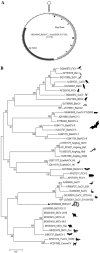The first reptilian circovirus identified infects gut and liver tissues of black-headed pythons
- PMID: 31097029
- PMCID: PMC6524214
- DOI: 10.1186/s13567-019-0653-z
The first reptilian circovirus identified infects gut and liver tissues of black-headed pythons
Abstract
Viral metagenomic analysis of the liver of a black headed python (Aspidites melanocephalus) euthanized for a proliferative spinal lesion of unknown etiology yielded the first characterized genome of a reptile-infecting circovirus (black-headed python circovirus or BhPyCV). BhPyCV-specific in situ hybridization (ISH) showed that viral nucleic acids were strongly expressed in the intestinal lining and mucosa and multifocally in the liver. To investigate the presence of this virus in other snakes and its possible pathogenicity, 17 snakes in the python family with spinal disease were screened with ISH yielding a second BhP positive in intestinal tissue, and a Boelen's python (Morelia boeleni) positive in the liver. BhPyCV specific PCR was used to screen available frozen tissues from 13 of these pythons, four additional deceased pythons with and without spinal disease, and fecal samples from 37 live snakes of multiple species with unknown disease status. PCR detected multiple positive tissues in both of the ISH positive BhP and in the feces of another two live BhP and two live annulated tree boas (Corallus annulatus). Preliminary analysis indicates this circovirus can infect BhPs where it was found in 4/5 BhPs tested (2/2 with spinal disease, 2/3 live with unknown status), Boelen's python (1/2 with spinal disease), and annulated tree boa (2/6 live with unknown status) but was not detected in other python species with the same spinal lesions. This circovirus' causal or contributory role in spinal disease remains speculative and not well supported by these initial data.
Conflict of interest statement
The authors declare that they have no competing interests.
Figures


Similar articles
-
Detection of nidoviruses in live pythons and boas.Tierarztl Prax Ausg K Kleintiere Heimtiere. 2017 Feb 9;45(1):22-26. doi: 10.15654/TPK-151067. Epub 2016 Oct 13. Tierarztl Prax Ausg K Kleintiere Heimtiere. 2017. PMID: 27735965 English, German.
-
Identification of snake arenaviruses in live boas and pythons in a zoo in Germany.Tierarztl Prax Ausg K Kleintiere Heimtiere. 2015;43(4):239-47. doi: 10.15654/TPK-140743. Epub 2015 Jun 25. Tierarztl Prax Ausg K Kleintiere Heimtiere. 2015. PMID: 26109078 English, German.
-
Detection of circovirus infection in pigeons by in situ hybridization using cloned DNA probes.J Vet Diagn Invest. 2001 Nov;13(6):475-82. doi: 10.1177/104063870101300604. J Vet Diagn Invest. 2001. PMID: 11724137
-
Inclusion body disease in snakes: a review and description of three cases in boa constrictors in Belgium.Vet Rec. 2006 Jun 3;158(22):757-60. doi: 10.1136/vr.158.22.757. Vet Rec. 2006. PMID: 16751310 Review.
-
Diagnostic Clinical Pathology of Boas and Pythons.Vet Clin North Am Exot Anim Pract. 2022 Sep;25(3):805-821. doi: 10.1016/j.cvex.2022.06.006. Vet Clin North Am Exot Anim Pract. 2022. PMID: 36122952 Review.
Cited by
-
Meta-Transcriptomic Discovery of a Divergent Circovirus and a Chaphamaparvovirus in Captive Reptiles with Proliferative Respiratory Syndrome.Viruses. 2020 Sep 25;12(10):1073. doi: 10.3390/v12101073. Viruses. 2020. PMID: 32992674 Free PMC article.
-
ContigExtender: a new approach to improving de novo sequence assembly for viral metagenomics data.BMC Bioinformatics. 2021 Mar 12;22(1):119. doi: 10.1186/s12859-021-04038-2. BMC Bioinformatics. 2021. PMID: 33706720 Free PMC article.
-
Diversity of CRESS DNA Viruses in Squamates Recapitulates Hosts Dietary and Environmental Sources of Exposure.Microbiol Spectr. 2022 Jun 29;10(3):e0078022. doi: 10.1128/spectrum.00780-22. Epub 2022 May 26. Microbiol Spectr. 2022. PMID: 35616383 Free PMC article.
-
The Analysis of Oral and Fecal Virome Detects Multiple Novel Emerging Viruses in Snakes.Transbound Emerg Dis. 2023 May 17;2023:4214812. doi: 10.1155/2023/4214812. eCollection 2023. Transbound Emerg Dis. 2023. PMID: 40303824 Free PMC article.
-
Circovirus in Blood of a Febrile Horse with Hepatitis.Viruses. 2021 May 20;13(5):944. doi: 10.3390/v13050944. Viruses. 2021. PMID: 34065502 Free PMC article.
References
MeSH terms
Grants and funding
LinkOut - more resources
Full Text Sources

